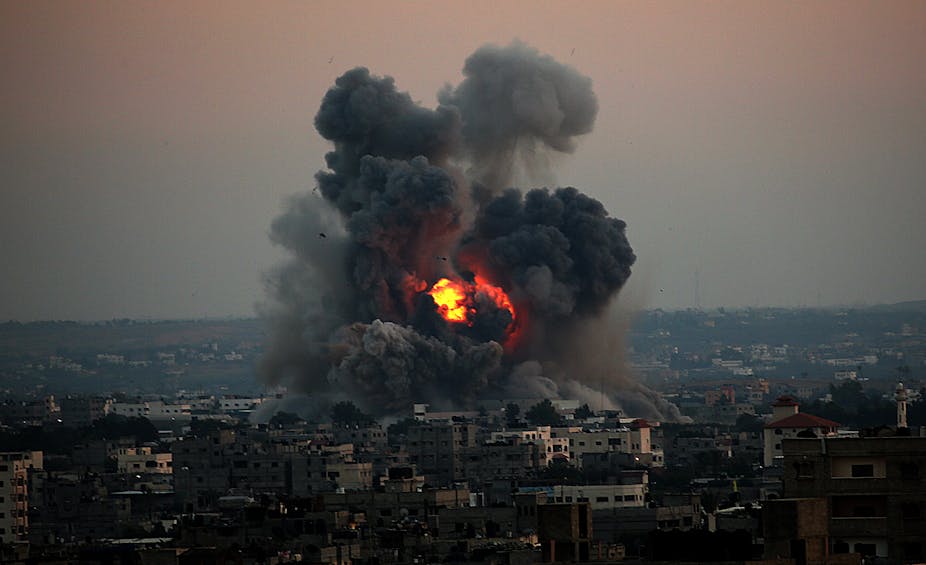The scorch marks and angry graffiti seemed familiar. The rubbish underfoot in the dust on the hard summer ground did, too. The calm suggested that something had changed. That impression grew. The officer from the Israeli border police took only a quick glance at my passport, pressed against the glass behind which she stood.
At the Qalandia checkpoint on the West Bank between Ramallah and Jerusalem, nearby fortifications were built of tall concrete slabs and fire had blackened one of the watchtowers. The flames had even disfigured part of the wall’s defiant decoration: a spray-paint portrait of the late Palestinian leader, Yasser Arafat.
I was coming back last week from doing interviews for a book: “Headlines from the Holy Land” which I am writing, about journalism and the Israeli-Palestinian conflict. My own interest stems from the two years, 2002-2004, I spent as the BBC’s correspondent in the Gaza Strip. The signs of violence and conflict that day reminded me of the countless times I crossed from Israel into Gaza, sometimes even as Israeli warplanes tore overhead on their way to hit targets in the crowded coastal territory.
The calm which seemed so striking a couple of weeks ago was, of course, deceptive – as violent conflict has erupted once again in the Gaza strip. Qalandia is not at the heart of the latest fighting, but it was incidents on the West Bank and in East Jerusalem – the beginning and end of my journey that day – which provided the spark.
In June, three Israeli teenagers were killed on the West Bank, which, along with Gaza, Israel occupied in a war with its Arab neighbours in 1967. The killing of a Palestinian teenager from East Jerusalem followed, apparently in revenge. Now Israel and Hamas, the Palestinian Islamist movement which controls the Gaza Strip, are engaged in their most serious military confrontation for almost two years.
Telling the story
Reporting from Gaza can be fascinating, frustrating, heartbreaking, and, sometimes, rewarding. It can also be difficult and dangerous. Pressures of deadlines, and the importance of accuracy – where you will never satisfy all members of your audience that you have been accurate – make it all the more demanding. Deciding to take the wrong turning at the wrong moment can put you in serious trouble, or worse. That is just for the international journalists.
Palestinian colleagues must also worry about their own families and property. At this particular time, almost all of them will also be observing a strict dawn-to-dusk fast for the Muslim holy month of Ramadan.
Telling the story is a real challenge. For even sticking to the basics prized by most news organisations in the English-speaking world: “who-what-when-where-why-how” presents endless dilemmas. The “why” in particular is a question with endless possible answers.
My recent research has led me to look at the work of my predecessors as correspondents in the region. The late British Conservative politician, Winston S Churchill (grandson of the wartime leader) was among them. He reported on the 1967 war. The book “Six Days”, which he co-wrote with his father, Randolph, takes the reader as far back as the Bible as a way of providing introductory context.

You do not need to go back quite that far to see the immediate causes of the current fighting. There is a grim familiarity about Israeli statements about “striking the terrorist infrastructure” (given Gaza’s dense population, this often involves killing civilians too) and Hamas’ threatening to “open the gates of hell”.
No winners – just losers
Having locked horns, both Israel and Hamas will have to strike at each other until they can separately claim victory. Past experience – and Israel’s “Iron Dome” missile defence system – suggest that more Palestinians than Israelis will be killed before that point is reached.
I was surprised by the calm at Qalandia that day, but not deceived. In the Israeli-Palestinian conflict, such moments – even if they last for months – are born of fatigue and resignation, not reconciliation.
Has anything really changed since I was in Gaza and Jerusalem a decade ago? Yes: the surrounding region, and not just that. War in Iraq and Syria has led many to conclude that the borders drawn up by colonial powers at the end of the First World War have had their day. Two decades years of talks aimed at defining borders for two states – Israel and Palestine – between the River Jordan and the Mediterranean – have failed, most recently in April.
For all it must be hellish now, Gaza could get worse. Two years ago, the United Nations asked whether it would be habitable by 2020.
“Operation Protective Edge”, as the Israeli Army has named its latest campaign, will not bring an end to the conflict. Rather, it will serve to remind the world of the problems which plague Palestinians and Israelis – even as neighbouring Iraq and Syria serve as reminders that discontented populations and military occupations, even national borders, may endure for decades, but not always for ever.

